

The queen of moussaka and ratatouille, eggplant is among those vegetables we’re happy to meet again in summer. To grow a fabulous harvest, follow our tips on how to care for it.
To learn more, read:
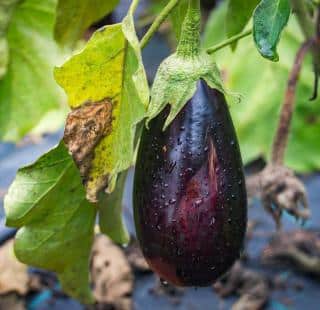 Eggplant requires regular watering. For each plant, you’ll have to water every 2-3 days if the soil is mulched. A potted eggplant will need watering more often because the soil dries out faster in containers. If this is the case, consider watering every single day, especially when the weather is hot. Since this vegetable cannot cope with sitting water, remember to toss out any extra water that drains out from the bottom of the pot.
Eggplant requires regular watering. For each plant, you’ll have to water every 2-3 days if the soil is mulched. A potted eggplant will need watering more often because the soil dries out faster in containers. If this is the case, consider watering every single day, especially when the weather is hot. Since this vegetable cannot cope with sitting water, remember to toss out any extra water that drains out from the bottom of the pot.
Of course, you can adjust these rules if it rains: natural rainfall will give you a few days of rest.
As for tomato, avoid getting leaves wet. Wet leaves are an invitation to fungal diseases like mildew. The method to keep leaves dry is to use a long-spout watering can, and water in a circular pattern around the base of your eggplant. When setting up your vegetable patch (or once it’s already in place), consider installing a drip irrigation system. It’s convenient and affordable when you compute the price of water!
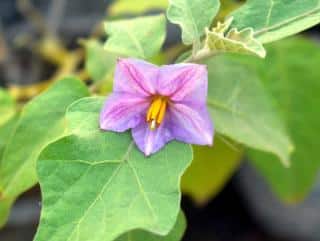 It’s best to water either early morning or evening.
It’s best to water either early morning or evening.
The most important factor here is to avoid the hotter hours when the sun shines strong.
Wet leaves and direct sunlight don’t mix well for plants.
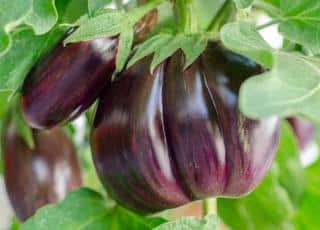 Fertilizer only helps once the first fruits are forming. Favor a fertilizer that contains lots of potassium: it supports fruit formation and growth. An example of a good fertilizer to use is comfrey weedy tea, which additionally has high amounts of phosphorus. Also use wood ash, if you have some, but don’t overdo it.
Fertilizer only helps once the first fruits are forming. Favor a fertilizer that contains lots of potassium: it supports fruit formation and growth. An example of a good fertilizer to use is comfrey weedy tea, which additionally has high amounts of phosphorus. Also use wood ash, if you have some, but don’t overdo it.
Lastly, a great option is to use seaweed which are naturally rich in potassium. They have the added advantage of soaking water up to keep it for later. However, don’t spread them under your plants right after collecting them. You have to remove the salt they contain first: stack them in a pile atop a tarpaulin in a corner of the garden. After 2-3 weeks, thanks to rain, your seaweed is ready for use.
 Good to know → A good time to gather seaweed is in winter: add them to your compost directly or start washing them out under the rainwater spout so that they’re ready for use in spring. Also, only gather seaweed that washes up on the beach. Don’t go pulling live seaweed from the beach’s ecosystem! Often, fish stores will have old seaweed that they use to decorate their displays, you can ask them for it and use that. Garden stores increasingly incorporate seaweed products in their soil mix and fertilizers.
Good to know → A good time to gather seaweed is in winter: add them to your compost directly or start washing them out under the rainwater spout so that they’re ready for use in spring. Also, only gather seaweed that washes up on the beach. Don’t go pulling live seaweed from the beach’s ecosystem! Often, fish stores will have old seaweed that they use to decorate their displays, you can ask them for it and use that. Garden stores increasingly incorporate seaweed products in their soil mix and fertilizers.
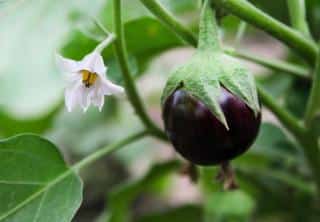 Pruning helps avoid growing flowerless stems (which won’t bear fruit). This maximizes production. Perform this from June to September. It’s a simple step: cut the main stem above the 2nd flower. This will trigger appearance of new stems lower down. Keep only the three most vigorous stems. On each of these, new flowers will appear.
Pruning helps avoid growing flowerless stems (which won’t bear fruit). This maximizes production. Perform this from June to September. It’s a simple step: cut the main stem above the 2nd flower. This will trigger appearance of new stems lower down. Keep only the three most vigorous stems. On each of these, new flowers will appear.
Also remove suckers that appear at the junction where stems connect to the main trunk.
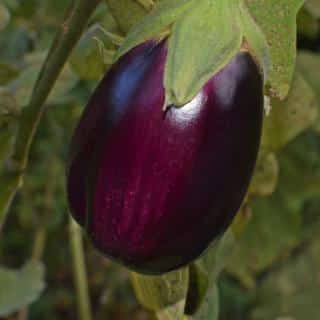 Eggplant harvest begins in July in warm climates, August wherever it’s cooler. Peel must be shiny and thin. Press your thumb down slightly on the fruit. If the mark disappears quickly, it means your eggplant is ready for harvest.
Eggplant harvest begins in July in warm climates, August wherever it’s cooler. Peel must be shiny and thin. Press your thumb down slightly on the fruit. If the mark disappears quickly, it means your eggplant is ready for harvest.
Don’t wait for too long before harvesting, or your eggplants will turn out more bitter.
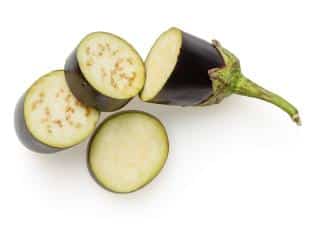 When preparing your eggplant for cooking, don’t throw out the seeds that are at the center! Recover them with a spoon, and rinse them out in cold water. Remove all the flesh and wrap them in a clean cloth to dry. Let them dry out for three weeks in the open, in a place that is well ventilated. Once the seeds are dry, slip them in an envelope and write the date and variety on it. You’ll be able to plant your own seeds from one year to the next! However, this seed collection technique only works for heirloom and non-hybrid varieties.
When preparing your eggplant for cooking, don’t throw out the seeds that are at the center! Recover them with a spoon, and rinse them out in cold water. Remove all the flesh and wrap them in a clean cloth to dry. Let them dry out for three weeks in the open, in a place that is well ventilated. Once the seeds are dry, slip them in an envelope and write the date and variety on it. You’ll be able to plant your own seeds from one year to the next! However, this seed collection technique only works for heirloom and non-hybrid varieties.
To learn more, read: